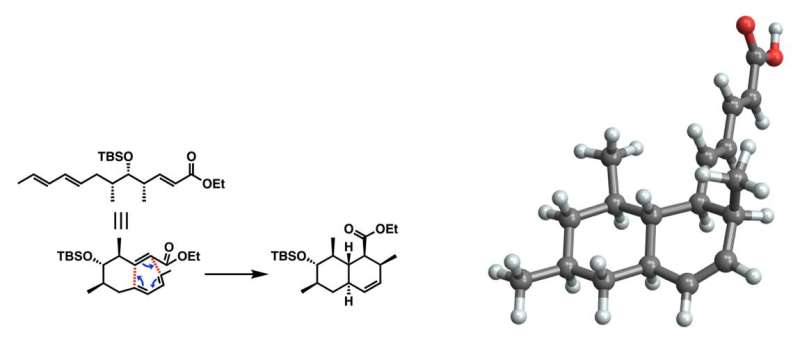This article has been reviewed according to Science X's editorial process and policies. Editors have highlighted the following attributes while ensuring the content's credibility:
fact-checked
peer-reviewed publication
trusted source
proofread
First artificial synthesis of tanzawaic acid B may lead the way to new antibiotics

The discovery of antibiotics in 1928 was a major turning point in the history of medicine. For the first time since the dawn of human civilization, doctors had gained access to an extremely powerful and effective tool to fight against a wide variety of bacterial infections. Today, bacterial diseases that were previously a death sentence can be cured, and infections following surgery or chemotherapy can be prevented or treated more effectively.
Unfortunately, the worldwide use (and abuse) of antibiotics led to the emergence of drug-resistant bacterial strains. Over time, bacteria that could normally be killed by a given antibiotic produced mutant offspring immune to it. These mutant strains are a major threat to public health, and the only safe course of action is to develop new antibiotic compounds.
Against this backdrop, a research team including Professor Isamu Shiina, Assistant Professor Takatsugu Murata and Mr. Hisazumi Tsutsui from the Tokyo University of Science (TUS) in Japan has now achieved a major breakthrough in the synthesis of new antibiotics. As reported in their paper published in ACS Omega in July 2023, the team achieved the first-ever gram-scale synthesis of tanzawaic acid B, which can serve as a candidate for the discovery of new drugs.
But what is tanzawaic acid B? In 1997, Professor Daisuke Uemura and colleagues working in the Tanzawa area of Japan isolated a series of organic polyketide compounds from the fungus Penicillium citrinum. These compounds were grouped together into what we now call the "tanzawaic" acid family, containing dozens of members ranging from A to Z1.
Tanzawaic acid B has attracted the most attention as it shares a common core structure with many tanzawaic acids, meaning that an artificial synthesis method for tanzawaic acid B could readily lead to synthesis methods for the rest.
However, synthesizing tanzawaic acid B from scratch is a challenging endeavor. The tanzawaic acids share a polysubstituted octalin skeleton—a structure composed of 10 carbon atoms in a tight pattern with multiple chemical groups at specific locations. The researchers synthesized this skeleton by utilizing a chain-like molecule that they had synthesized in a previous study. Then, by leveraging a carefully controlled intramolecular Diels-Alder reaction, they made these chains preferentially "fold" into the desired octalin skeleton.
The next challenge was to precisely modify the octalin skeleton in multiple steps to produce tanzawaic acid B. As octalin has eight carbon atoms that can participate in stereochemical reactions, any desired substitution effectively competes with 255 other possible arrangements.
To tackle this issue, the researchers employed asymmetric alkylation and asymmetric Mukaiyama aldol reaction, which enabled them to produce the desired polysubstituted octalin compound tanzawaic acid B on gram scale.
Overall, this new synthesis technique could play a key role in the development of antibiotic drugs based on tanzawaic acids. Prof. Shiina said, "For more than 25 years since its discovery, the total synthesis of tanzawaic acid B had not been realized, until now. The present synthesis method will hopefully lead to the creation of various compounds for pharmaceuticals in the future, including new antibiotic candidates for multidrug-resistant bacteria."
With a continuous, large-scale supply of tanzawaic acids, researchers will soon be able to test their interesting biological activities, including antibacterial, antimalarial, and antifungal properties. "Further improvements to the synthesis of tanzawaic acid B are currently underway, along with the investigations of its biological activity and synthetic analogs," concludes Prof. Shiina.
More information: Takatsugu Murata et al, First Total Synthesis of Tanzawaic Acid B, ACS Omega (2023). DOI: 10.1021/acsomega.3c03634. pubs.acs.org/doi/10.1021/acsomega.3c03634
Journal information: ACS Omega
Provided by Tokyo University of Science





















